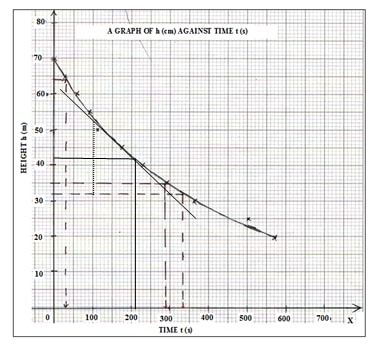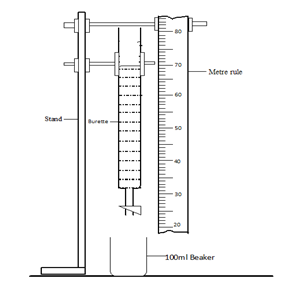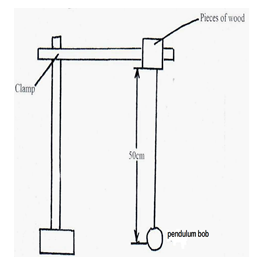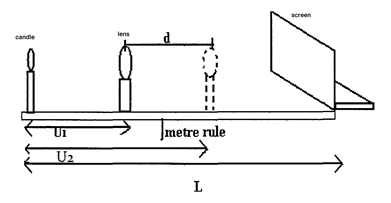QUESTION ONE
You are provided with the following apparatus
- A clean tap burette
- Retort stand
- Two clamps and 2 bosses
- A metre rule
- Water
- 100ml beaker
- A stop watch
PROCEDURE
- Clamp the burette and metre rule vertically and as close to each other as possible
- Adjust the position of the burette so that its lower end is 15cm above the bench and place the 100ml beaker underneath it.
- Fill the burette with water to a height above the 70cm mark of the metre rule as shown below.
- By trial and error method adjust the rate of flow of the water until the time taken for the water to flow from 70cm mark to 65cm is between 25-30 seconds.
- Once this flow rate has been achieved do not alter the flow rate for the rest of the experiment.
- Fill the burette again with water to a level above the 72cm mark.
- With the water level at the 70cm mark (at t=0) start the stop watch. Note the time taken for the height h of the water surface in the burette to decrease by 5cm;Do not stop the watch.
- Continue to record the time taken for the height h of water surface to decrease by successive 5.0cm marks till you have 10 more readings.
- Enter the results in the table below
- Reset the watch and refill the burette .
- Repeat the procedure to get second and third set of readings for t.(8marks)
Height h(cm)
Trial 1
Trial 2
Mean time t
70
65
60
55
50
45
40
35
- Complete the table above and calculate the mean time t
- Plot a graph of height h (y-axis) against mean time t (5marks)
- Use your graph to determine the time taken for the height h to change from 64cm to 42cm. (2marks)
- Find the gradient of the graph when h is 47 cm 3mks
QUESTION 2
PART A
You are provided with the following:
- Lens
- Lens holder
- Metre rule
- Screen
- A 70cm long thread.
- Clamp, boss and retort stand.
- Small pieces of wood.
- Pendulum bob
Proceed as follows: - Using the provided thread, tie the marble to be used as a pendulum clamp the thread so that the length l of the pendulum to the centre of the marble is 50cm as in figure 2.
- Displace the marble slightly so as to oscillate along the vertical plane.
- Time and record the time, t, for 20 oscillations.
t1 = ___S (1mk)
t2 = ___S (1mk)
tave=___S (1mk) - Calculate the period, T=___S (2mk)
- Calculate the frequency, f =___S (2mk)
- T2=__S (1mk)
- Convert L to metres, L= ___ (1mk)
- Calculate T2/L (1mk)
- If the oscillation of the marble is given by the formula.
determine the value of g. (3mks)
- Time and record the time, t, for 20 oscillations.
PART B
- Set up the apparatus as shown in figure 2 below. (ensure that the candle and the lens are in the line)
- With the candle placed a distance L =100cm from the screen, determine the position of a magnified image of the candle on the screen by moving the lens
- Determine the distance of the lens from the candle U1
U1………………………. .cm (1 mk) - Now move the lens towards the screen until you get a sharply focused diminished image. Determine the new distance of the lens from the candle U2
U2………………………cm (1 mk) - Calculate the displacement d of the lens (2 mk)
d = U2 — U1 = …………………….cm - Give that λ =
, calculate the value of λ (3 mks)
- By using a distant object, find the focal length f of the lens (1mk)
- compare the value in vi and vii (1mk)

MARKING SCHEME
QUESTION 1
PART A
|
H cm |
Trial 1 |
Trial 2 |
Mean time t(s) |
|
70 |
0 |
0 |
0 |
|
65 |
27 |
28 |
27.5 |
|
60 |
56 |
57 |
56.5 |
|
55 |
87 |
86 |
86.5 |
|
50 |
122 |
124 |
123.0 |
|
45 |
163 |
168 |
165.5 |
|
40 |
206 |
212 |
209.0 |
|
35 |
256 |
272 |
264.0 |
1 mark each row
- h=64cm; t=30.0s
h=42cm; t=210.0s
Time taken= 210 - 30= 180s - From the graph when h=35cm; t=290s
gradient = 32-52
300-100
= -20/200
=-0.1cms-1
QUESTION 2
PART A
- t1 = 28.44s +/- 3s
t2 = 29.50 s +/- 3s
tave = 28.97 s - 20 oscillations = 28.97S
1 oscillation = 1.448S
Period = T = 1.448s - f = 1/T
=1/1.448
=0.6906 Hz - T2=1.4482
=2.097 s2 - L = 50 cm = 0.5 m
- T2/L = 1.4482/0.5
=4.193s2m-1 -
g= 9.418N/kg
PART B
- U= 36.0 cm (1 mk)
- U = 70.0 cm (1 mk)
- d2=70.0 – 36.0 = 34.0 cm (1 mk)
-
= 22.11 cm (1 mk) - f=20.0cm +/-2cm (1mk)
- λ = f , the focal length of the lens (1mk)
Download PHYSICS PAPER 3 - KCSE 2019 BAHATI MOCK EXAMINATION (WITH MARKING SCHEME).
Tap Here to Download for 50/-
Get on WhatsApp for 50/-
Why download?
- ✔ To read offline at any time.
- ✔ To Print at your convenience
- ✔ Share Easily with Friends / Students







